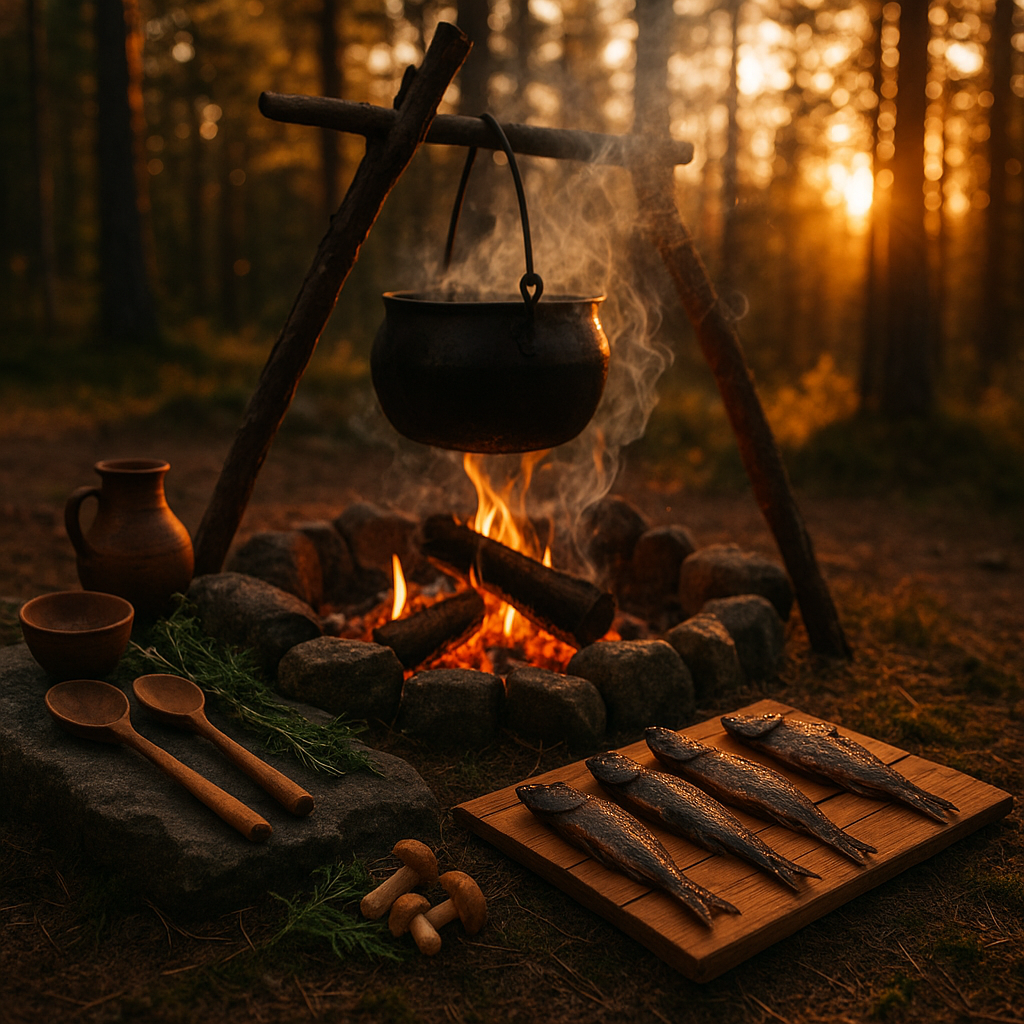Key Takeaways
- Reclaiming forgotten ancestral recipes offers a unique window into the ways our ancestors harmonized with nature to create sustenance, crafting meals that reflect deep respect for the land and its rhythms.
- Ancestral recipes embody resilience through simplicity. Ancient cooking methods used minimal, natural tools such as fire, stones, and foraged ingredients, demonstrating a remarkable adaptability in meeting the challenges of survival and nourishment.
- Wilderness cooking preserves oral traditions. Recipes passed down verbally weave cultural stories into the act of cooking, creating a living bridge between generations and enriching meals with meaning that extends beyond the food itself.
- Fire-cooking revives primal flavors. Techniques like roasting, smoking, and pit cooking over an open flame unlock layers of taste rarely found in modern kitchens, offering an elemental culinary experience that reconnects us to our senses.
- Food preservation is an ancient survival art. Methods like drying, salting, fermenting, and even burying food showcase the remarkable ingenuity of early communities that thrived in demanding environments.
- Every recipe carries cultural significance. These dishes represent more than sustenance; they hold rituals, celebrations, and legacy, reminding us of those who lived deeply attuned to place and season.
- Modern adaptations keep ancient methods alive. Today, outdoor enthusiasts and home cooks alike are reimagining ancestral techniques using contemporary tools and ingredients, blending old wisdom with present-day possibilities.
- Sustainability lessons emerge from ancestral food practices. By emphasizing zero waste, foraging, and reliance on locally sourced materials, these time-honored traditions closely align with modern eco-conscious values across industries such as environmental science, agriculture, and responsible tourism.
- Cooking in nature enhances connection to place. Preparing food outdoors invites mindfulness, encourages awareness of our surroundings, and creates bonds, whether around a campsite, in a community garden, or at a remote mountain hut, that traditional kitchens rarely offer.
Rediscovering ancestral cooking is not just about techniques or ingredients. It’s an invitation to reawaken wonder, mindfulness, and belonging through the rich tapestry of traditions woven into every recipe. In the following sections, we will explore these enduring practices and show how you can bring them alive in your outdoor adventures, culinary journeys, or sustainable living projects.
Introduction
A glowing ember, the scent of woodsmoke, and a handful of wild herbs. These are the building blocks of ancestral recipes once vital for survival, now nearly forgotten in modern life’s relentless chase for convenience. Before kitchens were lined with gadgets or shelves of store-bought ingredients, meals were crafted with intuition and a close relationship to the landscape. Each dish holds echoes of oral tradition, resilience, and a profound connection to the earth.
Choosing to rediscover traditional wilderness cooking is much more than a culinary experiment; it is an act of resourcefulness, mindfulness, and reverence for nature’s rhythms. Through ancient techniques of food preparation, fire management, and preservation, we unlock flavors and stories shaped by generations who lived with the land. As we journey through fire-based cooking and time-honored skills, we revive not just lost methods but a broader sense of belonging and sustainability, a shared feast by the fire, beneath endless horizons.
The Sacred Dance of Fire and Food
To understand ancestral recipes is to appreciate the elemental ritual that unfolds between flame, earth, and hands. The flicker of an open fire still resonates across eras and cultures, inviting us to a table as old as time.
Stay Sharp. Stay Ahead.
Join our Telegram Channel for exclusive content, real insights,
engage with us and other members and get access to
insider updates, early news and top insights.
 Join the Channel
Join the Channel
Ancient Wisdom in Modern Flames
Across continents, ancestral cooking traditions bear witness to sophisticated knowledge passed down not only for survival but also as an expression of ingenuity. In the Pacific Northwest, Indigenous peoples employed smoke preservation to keep salmon flavorful for months, using carefully chosen woods to enhance taste and inhibit spoilage. In the islands of Polynesia, earth ovens (heated with stones and buried under leaves) produced communal feasts, with each step grounded in generations of careful observation.
Archaeological studies in regions like the American Southwest showcase elaborate cooking pits engineered for precise heat regulation, decades before the invention of the modern oven. These remnants remind us that true innovation often means remembering and respecting what came before.
Beyond North America, similar wisdom flourished. Scandinavian communities cured fish with sea salt drawn from coastal inlets, while East African tribes mastered solar drying of grains to withstand long dry seasons. Each technique is a testament to the universal human quest for nourishment and resilience.
Preservation Techniques That Transcend Time
At the heart of survival in remote or challenging environments lies the mastery of food preservation, tuned to local resources and seasons. Traditional approaches include:
- Smoke Preservation: Infusing meats and fish with flavors from woods such as alder, mesquite, or hickory, a method used not only by Pacific Northwest tribes but also by Mongolian herders and Finnish hunters.
- Salt Curing: From Mediterranean fishing villages to Andean highlands, salt served as both protector and enhancer of flavor. Techniques varied by geography but shared the core goal of transforming food for longevity.
- Fermentation: In Korea, kimchi was buried in earthen jars to harness microbial transformation, while Scandinavian cultures fermented dairy and grains, inadvertently creating foods brimming with probiotics and preserved nutrients.
Current research confirms that many traditional preservation methods, now adapted by chefs, environmental scientists, and food technologists, create natural compounds rivaling synthetic preservatives. They foster bioavailable nutrients and help reduce reliance on refrigeration and artificial additives, offering models of sustainability relevant from field to laboratory.
The Language of Fire
Mastery in ancestral cooking begins with understanding fire. Each stage of flame, every glowing coal, and the scents of woodsmoke are clues for the attentive cook. Traditional fire-tending techniques include:
- Reading the Wood: Selecting wood species for desired combustion characteristics and flavor. For example, olive wood may impart earthy notes, while applewood brings sweetness.
- Temperature Control: Arranging stones, adjusting airflow, and managing ember placement to create designated hot and cool zones, much like a chef orchestrates a modern stovetop.
- Smoke Management: Using wind, shelters, or green branches to direct smoke for both flavor and preservation.
In forestry, fire management concepts borrowed from Indigenous knowledge serve modern conservation. Similarly, these approaches inspire both chefs and survivalists, uniting ancient practicality with present-day adventure.
A skilled fire-tender treats cooking as meditation, patiently watching embers, adjusting heat, and coaxing out the best in each ingredient. The process rewards presence, transforming meals into multi-sensory experiences and deeply rooted memories.
Seasonal Rhythms and Sacred Timing
Ancestral foodways are inseparable from natural cycles. Everything, from harvest to preparation to community feasting, aligns with the earth’s calendar:
- Maple Syrup Collection in North America begins as winter wanes and sap rises, guided not just by the thermometer but by the moon.
- Foraging for Wild Greens across the Mediterranean is tied to the soft rains of spring, and in East Asia, the first tea leaves signal both harvest and ritual.
- Fishing and Hunting Seasons are honored to prevent overharvesting, a practice echoed today in sustainable fisheries and wildlife management.
These seasonal traditions foster ecological stewardship, echoing the principle that true abundance comes from respect for nature’s boundaries. In modern agriculture, crop rotation and foraging practices increasingly draw inspiration from such ancestral wisdom.
Tools of the Ancestors
The implements of traditional cooking are deceptively simple yet ingeniously effective, each shaped by necessity and accumulated insight:
- Stone Cooking Surfaces: Used in diverse settings, from Native American hot stone soups to Himalayan flatbreads prepared on searing rocks, these surfaces distribute heat efficiently and impart subtle, mineral flavors.
- Wooden Utensils: Crafted from hard, antimicrobial woods like birch or olive, these tools develop a rich patina over decades of use, embodying sustainability and practical beauty.
- Clay Vessels: Porous, heat-retaining pots orchestrate gentle, even cooking. In North Africa, the tagine elevates stews; in the Indian subcontinent, clay ovens (tandoor) yield bread with unique texture and aroma.
Attempts to modernize these tools often miss nuanced design principles perfected through trial and error, like the rounded base that circulates heat more naturally than flat-bottomed metal pots. Such tools continue to inspire innovation, not only for chefs but also for product designers and engineers seeking efficiency and ecological harmony.
Revival of Lost Techniques
Today’s wilderness cooking revival is more than nostalgia. It is a global movement spanning culinary schools, outdoor education programs, cultural preservation groups, and even environmental policy:
- Pit Cooking: Practiced at community feasts in Australia, Latin America, an





Leave a Reply